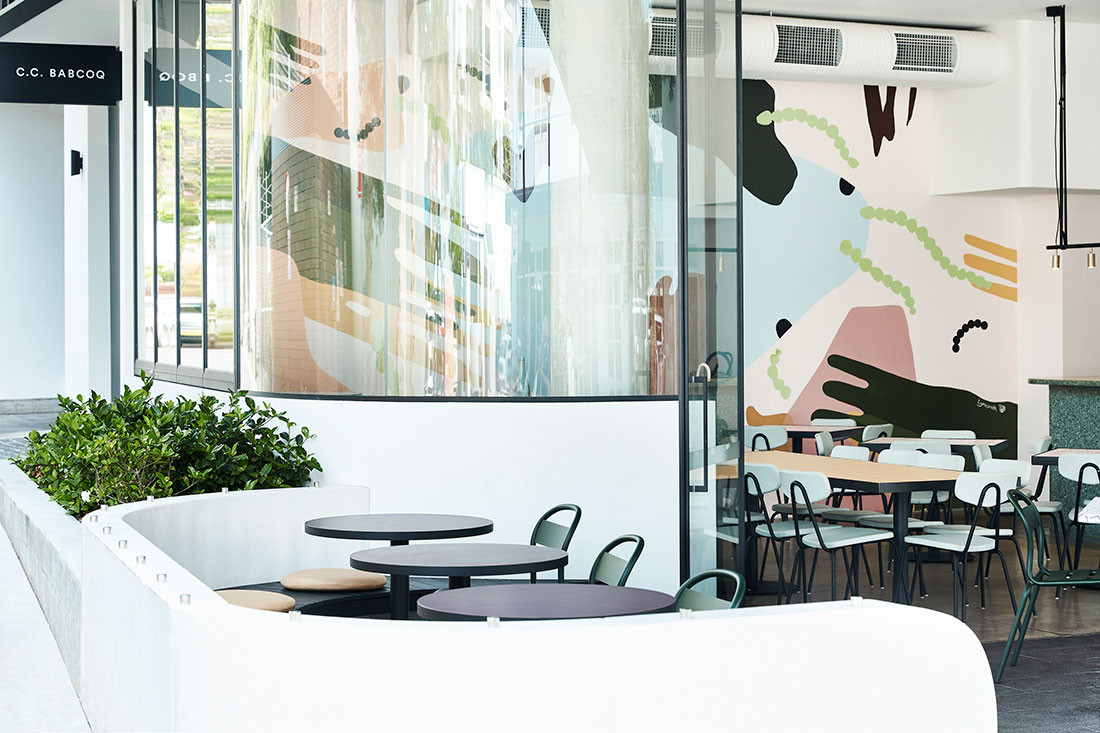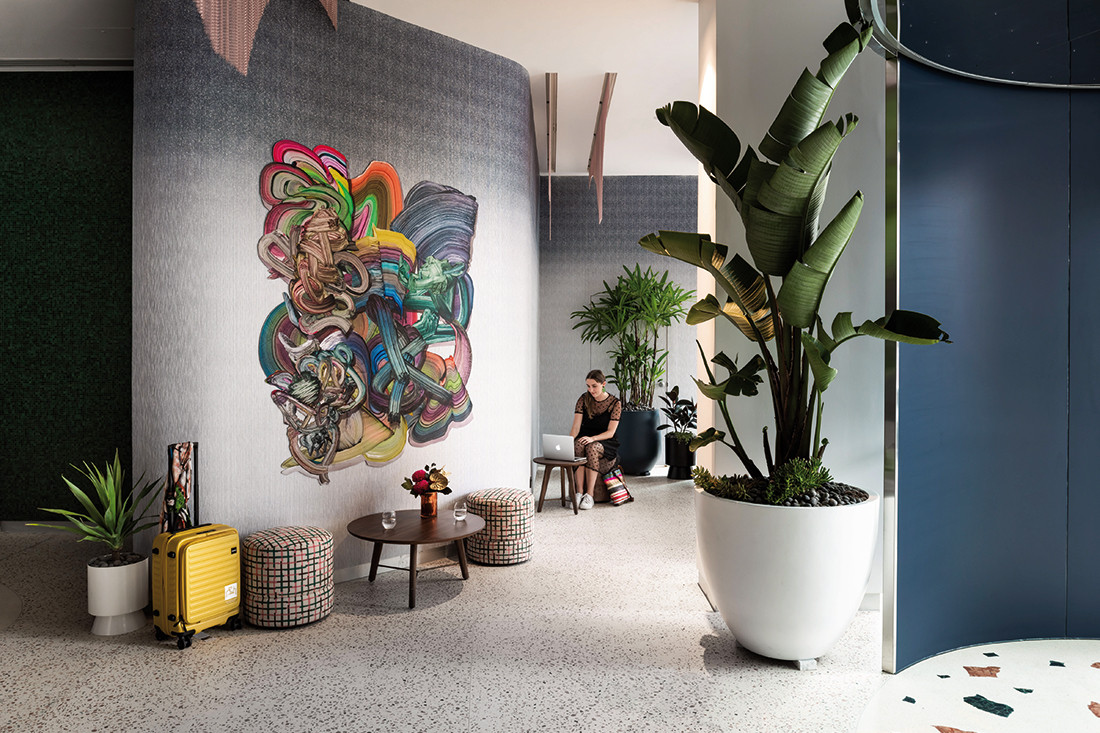With venues in popular locations boasting high star-ratings these days a dime-a-dozen, there is a new criteria being coveted in the hospitality scene.
August 24th, 2020
Like it or not, we are living in the Instagram Age. As the Mother of all Influencers, with an active user-base in the billions, Instagram’s powers of search and discovery are second only to Google. And for the first time since the beginnings of Bauhaus, we have good reason to beg the question: does form really still follow function? With the chances of finding a cafe, hotel, bar or restaurant in your ideal location and with a good star-rating, these days, a dime-a-dozen, Instagrammable places are amongst the most coveted of the hospitality scene.
Thanks to their inspired interiors and unique design concepts, these Insta-worthy cafés, hotels, bars and restaurants, spread across Sydney, Melbourne, Adelaide, Brisbane and beyond, are some of the most Instagrammable places in the world.
C.C. Babcoq in Cronulla, NSW, by TomMarkHenry


C.C. Babcoq is a rotisserie, carvery and cocktail bar in Cronulla named for Chastity Claire “C.C.” Babcock, Mr Sheffield’s secretary, on the ’90s sitcom The Nanny. Designed by TomMarkHenry, C.C. Babcoq is a fun and quirky space inspired by its namesake’s personality, and named one of the most Instagrammable places to eat in Sydney thanks to its nostalgic cred.
Ban Ban in Adelaide, SA, by Genesin Studio


The Korean fried chicken eatery is essentially a fast food joint on Franklin Street in the heart of Adelaide’s CBD. But Genesin’s colourful treatment of the 150-square-metre space via what he calls a “low-tech K Pop minimalism” has transformed it into an immersive customer experience memorable for its playful aesthetic.
Peaches, in Melbourne, by Pierce Widera


In times of high refinement and pared-back simplicity you don’t tend to hear the term ‘kitsch’ thrown about on a daily basis. For the vibrantly charming cocktail bar, Peaches, it’s the perfect definition for a vivid hospitality space located in the heart of Melbourne. This two-level whimsical wonder is a young and playful journey that takes you back to the wonders of 60s Modernism and 80s disco, with a splash of 90s noise.
The Joker and Thief, in Terrigal, by Fabric Architecture


Terrigal on the NSW Central Coast is your classic beach town with a long stretch of white sand, rolling waves and a buzzing esplanade. The Joker and Thief, however, is not your typical beach town venue. Designed by Fabric Architecture in collaboration with Stewart + Highfield, The Joker and Thief is where “Mad Men meets INXS,” as Brent Fitzpatrick, co-director of Fabric Architecture describes. It’s where 1960s mid-century modern has a 1980s glam-rock edge; where cocktail dresses comfortably sit alongside ripped jeans.
Chin Chin, Sydney, by George Livissianis



“Chin Chin has always been a bit of a bad-boy-bad-girl – and is proud of it!” says interior architect George Livissianis. True to word, it’s Chin Chin’s attitude that makes it one of the most Instagrammable places to eat. Livissianis speaks of Chin Chin in ways not dissimilar to directors speaking of their films. His attention to drama, narrative and detail play out through every facet: “It’s not just the dishes themselves, but the graphic treatment of the printed menus, the atmosphere of the room at lunch time as opposed to dinner, it’s the cartoon cookbook, the pink neon mascot, it’s the mirror-polished bar, the feathers and leathers. It’s about designing the conditions for a unique experience. And in this, the food is the hero.”
Ovolo the Valley, Brisbane, by Woods Bagot




Ovolo The Valley by Woods Bagot.
Iconic late artist David Bowie once said: “I don’t know where I’m going from here, but I promise it won’t be boring.” Bowie may have enjoyed a trip to Ovolo The Valley. The boutique hotel opened in November 2018 and radiates with glorious personality. With multilayered, sensory interiors designed by Woods Bagot, Ovolo The Valley warmly welcomes guests offering them a whimsical, artful journey, and one of Australia’s most Instagrammable places to stay.
John Anthony, Hong Kong, Linehouse


John Anthony is not only a feast for the taste buds, but also for the other senses. The textures, patterns, shapes and colours fused together by Linehouse create a sensory potpourri that makes the eyes wander and entices touch. The contemporary dim sum restaurant, opened by Maximal Concepts, is named after the first Chinese man to be naturalised as a British citizen in 1805. The employee of the East India Company sojourned from the East to London’s docklands to take care of lodging and food for arriving Chinese sailors in Linehouse’s Chinatown. The restaurant’s design is a spatial representation of his journey, hence the eclectic styles with hints of colonial architecture and Eastern detailing – or what the studio describes as “British tea hall turned Chinese canteen.” As such, formal elements meld with more quotidian components.
Gyoza Bar, Jakarta, AlvinT Studio


In the hands of the design team at AlvinT Studio, Gyoza Bar channels Japanese culture old and new, recognisable and subtle. With eye-catching Japanese inspired anime-esque graphics throughout, there’s little confusion as to the cuisine in the bar, and the custom-designed furniture matches this aesthetic, with a young and cheerful mood held in mind during the design process.
The Pink Zebra, Kanpur, India, by Renesa


The Pink Zebra, a high-concept restaurant in northern India, uses specific architectural and design styles to express the political history of a region. Designed by local studio Renesa, the project uses design to communicate the narrative of the site, from the bygone days of the British Empire to the films of Wes Anderson. Located inside one of the oldest structures in Kanpur – a major industrial city formerly known as Cawnpore – the architectural landmark has been described as a ‘concoction of design theories’. “The core idea was to create a design hybrid to leave the visitor hanging in the middle of an artistic sea,” says the design team.
SALT of Palmar, Mauritius, by Camille Walala


Scroll Instagram and images of SALT of Palmar will stop your finger in its tracks. Covered in French artist Camille Walala’s eye-popping bold colours, playful shapes and geometric patterns, this resort on the east coast of Mauritius is truly one of the world’s most Instagrammble places. But above and beyond being an Insta-worthy backdrop, the colours, shapes and patterns are an expression of the positive outlook of Mauritians and are intended to attract a younger tourist demographic to the traditionally older market.
Maze Hotel, Guangxi in Southern China, by Studio 10


Inspired by the work of famed Dutch graphic artist M.C. Escher, the Maze Hotel in the north-eastern province of Guangxi in Southern China was designed by a local firm, Studio 10, to break the traditional hospitality typology. During the initial research and discovery period, design director Shi Zhou came to understand that modern tourism is primarily about escaping reality – and discovering truly Instagrammable places.
Prestige Hotel, Penang, by Ministry of Design


Through a scheme encompassing brand strategy, interior design, landscape design, signage design, installation art and graphic design, Ministry Of Design explored the meshing of Victorian England with a verdant, tropical Malaysia. Culminating in a playful scheme of magic and visual illusions, where elements including levitation (floating beds), disappearing acts (an illusion in floor patterns), and Houdini’s escape boxes (showers and wardrobes) the hotel boasts the kind of augmented experience that is synonymous with the most Instagrammable places.
A searchable and comprehensive guide for specifying leading products and their suppliers
Keep up to date with the latest and greatest from our industry BFF's!

In this candid interview, the culinary mastermind behind Singapore’s Nouri and Appetite talks about food as an act of human connection that transcends borders and accolades, the crucial role of technology in preserving its unifying power, and finding a kindred spirit in Gaggenau’s reverence for tradition and relentless pursuit of innovation.

BLANCOCULINA-S II Sensor promotes water efficiency and reduces waste, representing a leap forward in faucet technology.

The Standard has opened in Singapore, offering sophisticated hotel and hospitality design amidst lush greenery in a serene pocket of the city.

In this comment piece, Buchan’s Dong Uong discusses the why and how behind the stories underpinning design projects.
The internet never sleeps! Here's the stuff you might have missed

CDK Stone’s new Selection Centre is crafted specifically for the design community, providing a dedicated space for architects, designers and specifiers to explore, collaborate, and take clients on an immersive journey through premium natural stone.

It’s been an extraordinary ten years of exemplary projects from Studio Tate, and accolades go to Alex Hopkins and the team for an exemplar decade.

Urban designers, landscape architects master-planners and principal consultants TCL have announced the winner of their distinctly multidisciplinary residency program.

Knoll’s revolutionary legacy, from its pioneering mid-century modern origins to its current place within the MillerKnoll collective, continues to shape the spaces we inhabit. Here, we explore the iconic institutions, influential collaborations, and groundbreaking ideas that have shaped Knoll’s unique understanding of the human-space connection — the bedrock of the brand’s enduring relevance.